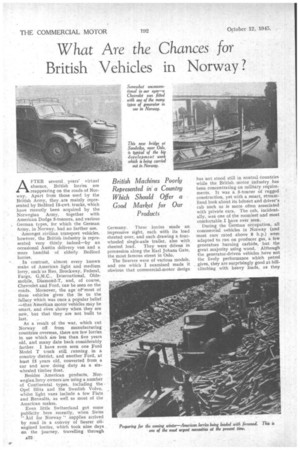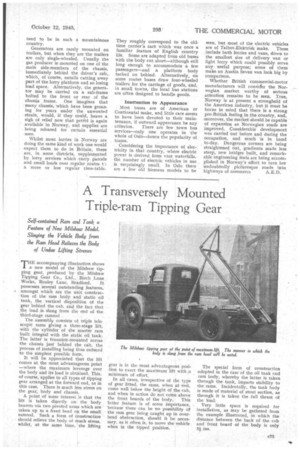What Are the Chances for
Page 24

Page 25

If you've noticed an error in this article please click here to report it so we can fix it.
British Vehicles in Norway?
British Machines Poorly Represented in a Country Which Should Offer a Good Market for Our Products
AFTER several _ years' virtual absence, British lorries are reappearing on the roads of Norway. Apart from those used by the British Army, they are mainly represented by Bedford 15-cwt. trucks, which have recently been acquired by the Norwegian Army, together with American Dodge 3-tonners, and various German types, for which the German Army, in Norway, had no further use.
Amongst civilian transport vehicles, however, the British industry is represented very thinly indeed—by an occasional Austin delivery van and a mere handful of elderly Bedford lorries.
In contrast, almost every known make of American light and medium lorry, such' as Roo, Brockway, Federal, Fargo, G,M.C., International, Oldsmobile, Diamond-T, and, of course, Chevrolet and Ford, can be seen on the roads. Moreover, the age of-most of these vehicles gives the lie to the fallacy which was once a popular belief —that American motor vehicles may be smart, and even showy when they are new, but that they are not built to last.
As a result of the war, which cut Norway off from manufacturing countries overseas, there are few lorries in use which are less than five years old, and many date back considerably farther. I have even seen one Ford Model T truck still running in a country district, and another Ford, at least 15 years old, converted from a car and now doing duty as a sixwheeled timber float.
Besides 'American products, Norwegian lorry owners are using a number of Continental types, including the Opel Blitz and the Swedish Volvo, whilst light vans include a few Fiats and Renaults, as well as most of the American makes.
Even little Switzerland got some publicity here recently, when Swiss " Aid for Norway " supplies arrived by road in a convoy of Saurer oilengined lorries, which took nine days on the journey, travelling through A22 Germany. These lorries made an impressive sight, each with its load sheeted over, and each drawing a fourwheeled single-axle trailer, also with sheeted load. They were driven in procession along thc Karl Johans Gate, the most famous street in Oslo.
The Saurers were of various models, and one which I examined made it obvious that commercial-motor design has not stood still in neutral countries while the British motor industry has been concentrating on military requirements. It was a 5-tonner of rugged construction, yet with a smart, streamlined look about its bannet and driver's cab such as is more often associated with private cars. The cab, incidentally, was one of the roomiest and most comfortable I have ever seen.
During the German occupation, all commercial vehicles in Norway (and most cars rated above 8 h.p.) were adapted to run on producer gas, a few generators burning carbide, but the great majority using wood. Although the generator-driven vehicles have not the lively performance which petrol gives, they are surprisingly good at hillclimbing with heavy loads, as they need to be in such a mountainous country.
Generators are rarely mounted on trailers, but when they are the trailers are only single-wheeled. Usually the gas producer is mounted on one of the main side-members of the chassis, immediately behind the driver's cab,_ which, of course, entails cutting away part of the lorry platform and so losing load space. Alternatively, the generator may be carried on a sub-frame bolted to the front or rear of the chassis frame. One imagines that many chassis, -which have been groaning for years under the unwonted strain, would, if they could, heave a sigh of relief now that petiol is again available in Norway, and supplies are being released for certain essential uses.
Whilst most lorries in Norway are doing the same kind of work one would expect them to do in Britain, these are, in some districts, supplemented by lorry services which carry parcels and small loads over regular routes t-> a more or less regular time-table.
They roughly correspond to the oldtime carrier's cart which was once a familiar feature of English country life. Some are adapted from old buses with the body cut short—although still long enough to accommodate a few passengers—and a platform body tacked on behind. Alternatively, on some routes buses draw four-wheeled trailers for the carriage of goods, and, in small towns, the local bus stations are often designed to handle goods.
Inattention to Appearance Most buses are of American or Continental make, and little care seems to have been devoted to their maintenance, if outward appearance be any criterion. There are few town bus services—only one operates in the whole of Oslo—hence the popularity of trams.
Considering the importance of electricity in that country, where electric power is derived from vast waterfalls, the number of electric vehicles in use is surprisingly small, In Oslo there are a few old Siemens models to be
seen, but most of the electric vehicles are of Talbot-Elektrisk make. These include both lorries and vans, down to the smallest size of delivery van or light lorry Which could possibly serve any useful purpose; some of them make an Austin Seven van look big by comparison.
Whether British commercial-motor manufacturers will consider the Norwegian market worthy of serious attention remains to be seen. True, Norway is at present a stronghold of the American industry, but it must be borne in mind that there is a strong pro-British feeling in the country, and, • moreover, the market should be capable of expansion as Norwegian roads are improved. Considerable development was carried out before and during the occupation, and much is in hand to-day. Dangerous corners are being straightened out, gradients made less steep, new bridges built, and remark. able engineering feats are being accomplished in Norway's effort to turn her undoubtedly picturesque roads into highways of commerce A.E.D.




















































